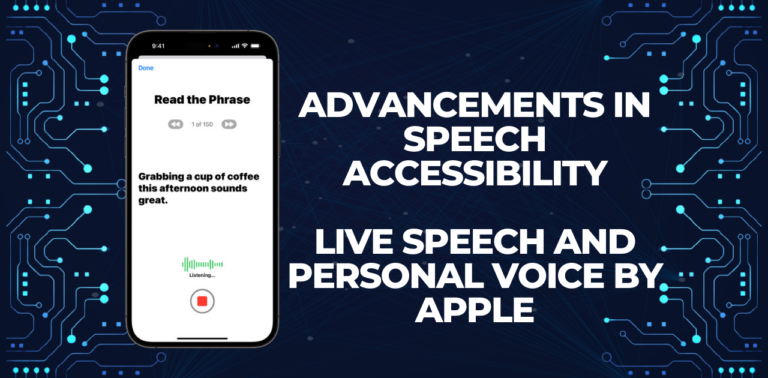
Advancements in Speech Accessibility: Live Speech and Personal Voice by Apple
Augmentative and Alternative Communication (AAC) has taken significant strides forward in transforming how individuals with speech and communication difficulties express themselves. A shining example is the introduction of Apple’s Live Speech and Personal Voice features. However, an AAC app called Speech Aid has been quietly surpassing expectations as a top-rated text-to-speech solution that has continued to innovate in the space.
How helpful is Live Speech?
Live Speech is one of Apple’s latest introductions, providing a basic tool directly from their devices for people who struggle with verbal communication. This feature converts typed words into spoken language during phone calls, FaceTime calls, and even face-to-face interactions, allowing for a seamless and natural communicative experience for those that need it. By integrating Live Speech into the text-to-speech process, individuals can enjoy a more interactive and accessible means of communication.
Text-to-voice features in real-life situations can be life-changing. Imagine an individual with ALS, a condition that unfortunately gradually affects the nerve cells controlling the muscles, which causes them speech difficulties. Live Speech can certainly help them as a starting point, allowing them to participate in conversations and express their thoughts and feelings. Here’s where the Speech Aid app comes into play, acting as a conduit for such revolutionary features to reach users who need them the most.
The Power of Personal Voice
Complementing Live Speech and Speech Aid is Apple’s new feature, Personal Voice, that enables users to create a synthetic voice resembling their own. This is a significant leap in AAC, particularly for those at risk of losing their ability to speak. Instead of relying on a standard synthetic voice that users can select from the voices section on Speech Aid, users can communicate using a familiar voice – their own. Speech Aid, a text-to-voice app, will also allow users to select their voice when using the app to enable them to use it with a purpose-built app.
Imagine a person that has recently been diagnosed with a condition that progressively affects their ability to speak, such as Multiple Sclerosis. With Personal Voice, they can bank their voice, preserving their unique vocal identity and continue to “speak” in a voice that is inherently theirs.
But what if these individuals could take this a step further? This is where Speech Aid aims to break new ground, planning to incorporate Personal Voice, letting users express themselves with their unique voice more personally and emotionally.
Speech Aid: Your Personal AAC Solution
As a text-to-speech AAC app, Speech Aid has long been helping individuals communicate who otherwise might not be able to. It has been designed for those that are non-verbal or those with limited speech capabilities due to various conditions such as autism, stroke-induced aphasia, learning difficulties, cerebral palsy, and many more.
Speech Aid provides a simple, user-friendly platform for converting text into spoken words. Users can save frequently used phrases, organise them into easy-to-access categories, and customise the app to suit their needs and goals. Whether it’s expressing an immediate need or engaging in a lively conversation, Speech Aid is an indispensable communication tool for its users.
Integrating Apple’s Live Speech and Personal Voice features into Speech Aid is the next logical step in AAC development and Speech Aid’s development team’s commitment to continue to develop an app that helps its users. Imagine users having their unique voice seamlessly integrated into Speech Aid, increasing the naturalness of its user’s voice when communicating and enhancing the emotional connection during conversations.
For those that are dealing with conditions like autism or cerebral palsy, where communication can often be challenging, the opportunity to ‘speak’ with Speech Aid through their Personal Voice can be empowering. This advancement brings us closer to a future where AAC devices, like Speech Aid, facilitate communication and provide a platform for individuals to express themselves in their voices.
FAQs
1. What is AAC and why is it important?
AAC, or Augmentative and Alternative Communication, is a range of strategies and tools that can be used to assist individuals with speech and communication difficulties. This can include everything from sign language and picture symbols to modern day high-tech devices like Speech Aid that convert text into speech.
2. How to use Apple Live Speech?
With Live Speech on iPhone, iPad, and Mac, users can type what they want to say, and it will be spoken out loud during phone and FaceTime calls, as well as in-person conversations. This feature is particularly useful for individuals who are unable to speak or who have lost their speech over time.
3. How does Speech Aid work?
Speech Aid is a text-to-voice app where its users can type what they want to say and have it spoken aloud. It has been designed for individuals that have difficulty speaking due to conditions such as autism, cerebral palsy, or after a stroke and many other conditions.
4. What makes Speech Aid unique among other AAC apps?
Speech Aid stands out because of its user-friendly design, customisation options, and commitment to continually integrating advanced features like Apple’s Live Speech and Personal Voice to a purpose built solution for those with speech impairments. It provides an effective and personalised AAC solution for individuals that struggle with speech and communication in their daily life.
5. How can I get started with Speech Aid?
Getting started with Speech Aid is as simple as downloading the app and signing up for a free trial from Apple’s AppStore – available on iPhone, iPad and Mac. Users can then explore the app, customise it according to their needs, and use it to facilitate daily communication.
6. Can Speech Aid App help with learning difficulties?
Yes, Speech Aid App can be a very valuable tool for individuals with learning difficulties, providing a means to communicate effectively and confidently to help remove the frustration from daily communication.